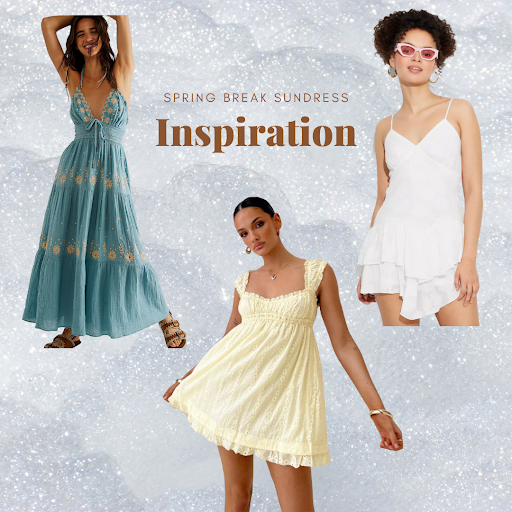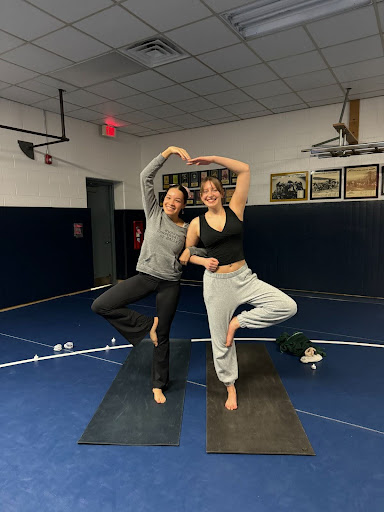My shoulders aren’t distracting

From left to right: Haelo Graff, Natalia Selvaggio and Sophia Ferrazza.
April 29, 2019
The dispute between student and administration surrounding dress code regulations has been continuous. While there are a variety of dress codes and enforcement, the foundation of dress codes are incorporated into most school policies. Though dress codes are meant to create a balance between all students and facilitate an aura of professionalism in the school setting, they can be discriminatory towards females or create unnecessary restrictions. Among the student body it is the idea that there shouldn’t be a fault in one student or another acting as a “distraction” for the way they dress. Dress codes put responsibility on students, yes, but also blame and that needs to be taken away.
Solon High School’s (SHS) dress code prohibits cold shoulder shirts, midriff exposure and more. Discrimination against certain body types occur because of the way clothing is cut, and appears differently, discrimination against gender fashion occurs because of popular trends that happens in women’s fashion, and there is no controlling it. Regardless of school policy and teacher responsibility to enforce the dress code, many teachers decide for themselves if they will impose it, thus leaving it to personal opinion. This unpredictability is where the unevenness comes to play and where people find themselves feeling personally targeted by the dress code. A “distracted” student, bothered by shoulders, kneecaps, and collarbones, should not be the reason to place restrictions on personal fashion choices.
Girl Up Advisor Kelly Fishman comments on the way we represent ourselves through our style but how it could be unintentionally oppressed by the dress code.
“I was the dress code committee chair a few years ago, and then I’m also the advisor for Girl Up, so it brings up a lot of sticky points because I do feel like all of us, every human being, use the way we dress to kind of create our identity and show who we are,” Fishman said. “I think the thing that’s tricky for students, and I remember as a student I struggled with this too, [is] being able to create that line between your identity and what’s appropriate for school, so I think that’s where we get into the sticky point. The idea that you want to show who you really are, but there are things I would wear out with my friends that I wouldn’t wear to work.”
The problem is then how the dress code indirectly targets certain demographics, specifically women’s fashion.
”The way we comment on the way people dress is usually directed towards women, and so it builds this culture of victim shaming and slut shaming, which is something we talk a lot about in Girl Up, but also understanding that when you come to school, you might have a really cute bodycon dress but maybe that’s for going out with your friends,” Fishman said. “It’s not really necessarily appropriate for a school presentation because it’s a different context.”
She continued, saying that regardless of what may be deemed appropriate or not, there is no controlling how another student could perceive it.
“Boys are going to be distracted no matter what because developmentally, that is where they are,” Fishman said. “We’re talking huge influx of hormones for boys and girls, and so they’re going to notice a cute [person] whether they’re in a baggy sweatshirt and jeans or a crop top and leggings.”
Fishman goes on to say that it is females that are typically the ones getting dress coded and because of that, it has become a verb ‘to get dress coded.’
SHS Assistant Principal Joshua Frazier mentioned some of the possible reasons that the school board uses to justify certain aspects of the dress code.
“Maybe if girls are wearing tank tops, maybe it’s exposing part of their breasts or bra straps or something like that,” Frazier said. “It’s the same thing as guys sagging their pants and having their undergarments showing. I think that’s where people draw the line.”
The way the dress code is implemented forces teachers and students into uncomfortable situations. Furthermore, there is inconsistency among teachers when deciding to dress code or not. SHS teacher Karen Smith believes similarly that there needs to be all around regularity.
“There’s definitely a teacher component in terms of choosing to enforce versus not enforce. I think the idea with wearing hats or hoods, I think there needs to be greater consistency across the board from both teachers and administration that keeps it consistent for all students. There’s examples in which they allow some students to wear hoods and others not.”
When a teacher does enforce the dress code, it then creates tension between the relationship between student and teacher.
“I think in terms of female dress, I think it’s really hard for male teachers to say something to female students about what they’re wearing because it creates this sense of awkwardness, and I think it’s easier for female teachers to say something to female students” Smith said.
Frazier also notices that there are some uncontrollable factors when dress coding someone. Different body types reveal more or less even when wearing the same piece of clothing.
“I think with dress code, the criticism is that it may not be fair, and I think people really feel like there’s a lot of disparity or inequity when enforcing dress codes, Frazier said. ”If you are a smaller female, you can get away with wearing something but if you’re tall or if you are plus-size then someone will say ‘Hey, that’s inappropriate’ and say ‘Well this girl has [something on]’ but maybe it makes someone more uncomfortable.”
Dress codes are put in place to have everyone in the same playing field and make sure that there is appropriateness and maturity when choosing what to wear to school, but the reality is that when it comes to dress coding, there are uncontrollable factors.
Fishman notes how the responsibility falls on the student who is “distracted.”
“In Girl Up we talk about this idea of toxic masculinity and slut shaming so we’re looking at both sides and how, as women, we tend to be the ones that push each other down but we need to hold each other up,” Fishman said. “But then we also make it okay to say to a girl ‘don’t dress like that because it distracts boys’ except then you’re allowing it to be okay for boys to be distracted.”
The idea behind the dress code is understandable, but there is indirect targeting that has many students left feeling unhappy and it needs to be reevaluated or removed.











Madeline Bentz • May 10, 2021 at 1:23 pm
Personally, I am top-heavy, so I cannot wear most shirts. The only thing within my school dress code I can wear makes me look like a catholic nun and Marry Poppins had a child.